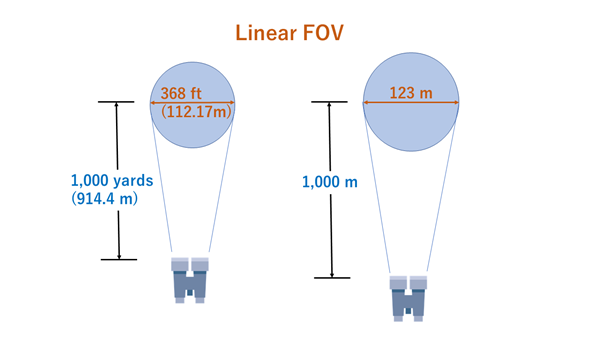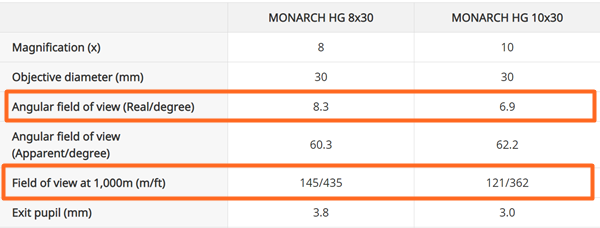When someone says, “These binoculars have a wide field of view,” you might assume that you can see a wide-angle view. But this is not always true.
In the specifications, you will find the field of view described like this: 368ft at 1000yds. However, you will also find it described in the angular field of view: 56 degrees.
With both of these related to the field of view, it becomes confusing to compare one pair with another.
I’ll explain the different types of field of view with some specific examples. I’ll also tell you the best field of view width for beginners.
Contents
Two ways to describe the field of view
In the specifications, you will notice two ways to describe the field of view (FOV). Here are the examples.

https://www.leupold.com/binoculars/hd-binoculars/bx-4-pro-guide-hd-8x42mm
On Leupolds’s website, FOV is described by the linear field of view. This indicates the width of the view through the binoculars at 1,000 yards and 1,000 meters.

However, on Nikon’s website, FOV is described by the angular FOV as well as the linear FOV.

https://imaging.nikon.com/lineup/sportoptics/binoculars/monarch/monarch_hg_x30/spec.htm
To help you convert these numbers, below is a Field of View Conversion Table. This will come in handy when comparing the FOV of different pairs when you buy binoculars.
The Field of View Conversion Table
| Real FOV | m @1,000m | ft @1,000yds |
| 6.0 | 105 | 315 |
| 6.1 | 106 | 320 |
| 6.2 | 108 | 325 |
| 6.3 | 110 | 331 |
| 6.4 | 112 | 336 |
| 6.5 | 113 | 341 |
| 6.6 | 115 | 347 |
| 6.7 | 117 | 352 |
| 6.8 | 119 | 357 |
| 6.9 | 121 | 363 |
| 7.0 | 123 | 368 |
| 7.1 | 124 | 373 |
| 7.2 | 126 | 378 |
| 7.3 | 128 | 384 |
| 7.4 | 129 | 389 |
| 7.5 | 131 | 394 |
| 7.6 | 133 | 400 |
| 7.7 | 135 | 405 |
| 7.8 | 136 | 410 |
| 7.9 | 138 | 416 |
| 8.0 | 140 | 421 |
| 8.1 | 142 | 426 |
| 8.2 | 144 | 432 |
| 8.3 | 145 | 437 |
| 8.4 | 147 | 443 |
| 8.5 | 149 | 448 |
| 8.6 | 151 | 453 |
| 8.7 | 153 | 459 |
| 8.8 | 154 | 464 |
| 8.9 | 156 | 469 |
| 9.0 | 158 | 475 |
The difference between Real FOV and Apparent FOV
Let’s take a closer look at Nikon’s specifications. There are two types of angular FOV: Real FOV and Apparent FOV. People sometimes confuse these (see below).

To help you understand the difference, I’ve made a model of binoculars using a couple of toilet rolls. Since these binoculars don’t have any lenses or prisms, they have a magnification of 1×.
I put three stuffed animals by a window and looked at them through this pair from 2 meters away.
You can see three stuffed animals in the same image circle. In the picture taken from behind the binoculars, you can see the Real FOV (see below).


As I said, real FOV is expressed in either liner FOV or angular FOV.
・Apparent FOV
Apparent FOV indicates how wide your view is when you look through the binoculars. Here is a picture to show Apparent FOV.
50 degrees of Apparent FOV is considered to be standard. Binoculars with the standard Apparent FOV give you a relatively good image even in the peripheral area, although the image is sharpest in the center of the field.
Apparent field of view wider than 65 degrees is considered a wide field of view. The ocular lens, also called an Erfle eyepiece, makes it possible to produce such a wide-angle.
When you look through high quality, wide-angle binoculars, you get the impression that you are looking through a large picture window.
However, wide-angle binoculars tend to cause distortion and vignetting in the peripheral area. Some amateur astronomers choose standard angle binoculars in order to get a flat view.
Bird watchers prefer wide-angle binoculars to find birds quickly. Seeing their target in the middle of the field of view, they can get a sharp image without distortion and vignetting.
Whether you choose wide-angle binoculars or not depends on your preference and budget.
What is the best field of view for beginners?
Generally speaking, as the magnification gets higher, the real FOV gets narrower. If you want a wide FOV, you’ll need to get wide-angle binoculars with an apparent FOV of more than 65 degrees.

Left: standard angle, Right: wide-angle.
For example, if you have a pair of 8×40 with a FOV of 7 degrees, its apparent FOV will be about 56 degrees (slightly wider than the standard).
Then, if you want to buy another pair of 10×40 with the same real FOV (7 degrees), you’d need ones with an apparent FOV of 70 degrees.
For beginners, I recommend binoculars with at least 7 degrees of real FOV because it’s easier to spot their targets quickly.
Considering the distortion and vignetting in the peripheral area, 8× should be the upper limit for beginners.
With 8×, you only need 56 degrees in apparent FOV to get a 7 degree real FOV.
When I visited a binocular factory, I learned some interesting facts about FOV. Reading this article (A Visit To A Binocular Factory, Otsuka Optical CompanyA Visit To A Binocular Factory, Otsuka Optical Company), you’ll understand that being too particular about wide-angles can be nonsensical.
Summary
The term field of view (FOV) can be confusing because there are two different measurements used. One is the linear FOV and the other is the angular FOV. In the U.S., FOV is usually described as XX ft at 1,000 yds.
Also, there are two different FOVs: Real FOV and Apparent FOV. The FOV I mentioned above is the Real FOV.
Apparent FOV indicates how wide your view is when you look through the binoculars. This will depend on the optical design of the ocular lenses.
When beginners choose binoculars, it’s important to think carefully about FOV. Wide-angle binoculars are the easiest to use, although the image in the peripheral area tends to be worse.
